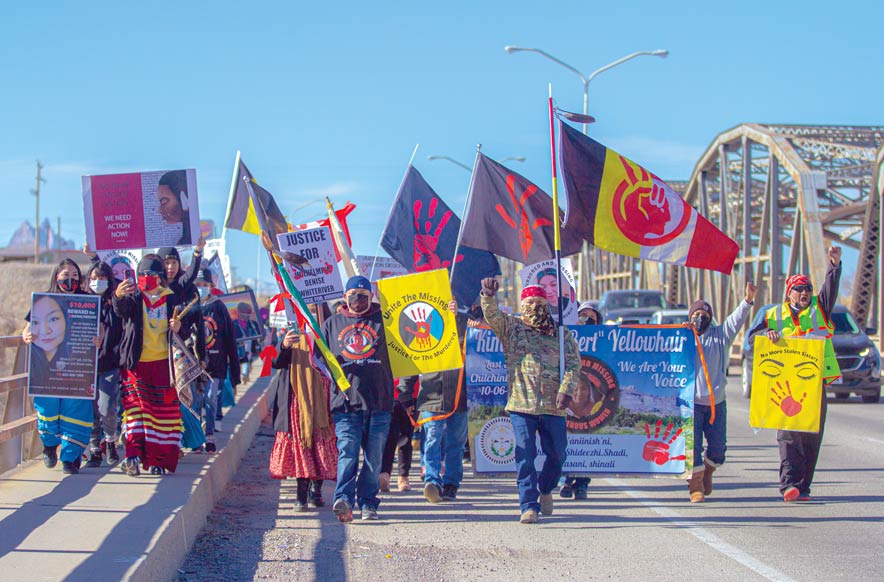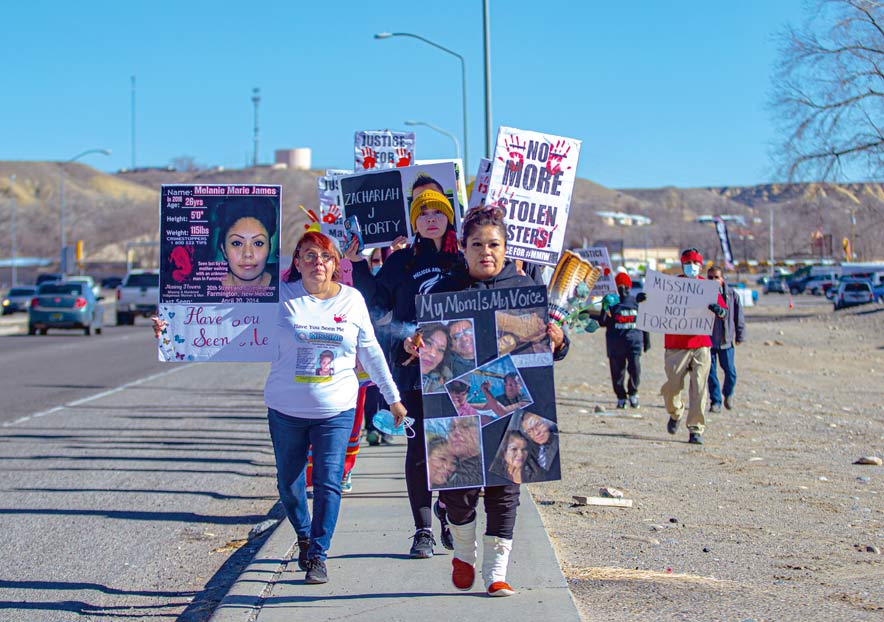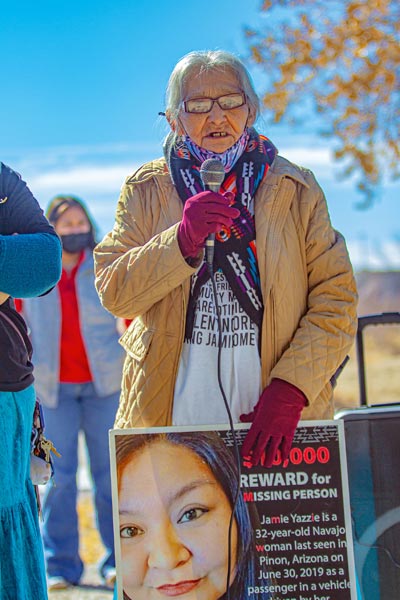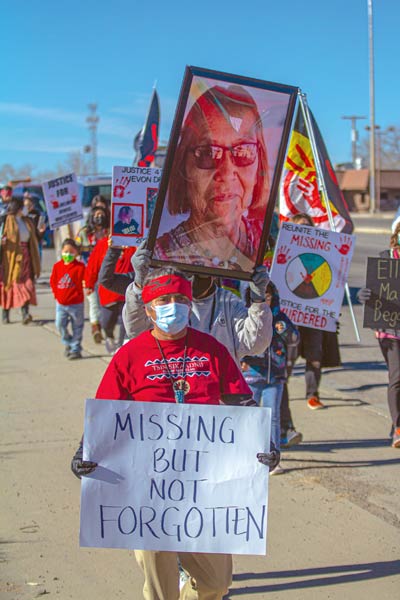
‘I’m not the only one’: Families of missing, murdered walk for attention, comfort

Navajo Times | Cyrus Norcross
Family and supporters of Missing and Murdered Indigenous People walk across the Shiprock bridge on Jan. 26.
SHIPROCK
Nearly 100 people walked from the four directions carrying signs, with red handprints on them, toward Nizhoni Park on the morning of Jan. 29 in memory of the missing and murdered Indigenous women.
Supporters of MMIW and families who have lost loved ones joined the five-mile walk to raise awareness of missing people on the Navajo Nation.
The walk was organized by Seraphine Warren, who has been searching for her aunt, Ella Mae Begay, for seven months.
Warren and other families approached the walk as if it were a ceremony and walked in prayer from the four directions toward the park.
“As I was being raised, I was always told to take care of the land and pray for it and that we are protected by the four sacred mountains,” Warren said, “We approach everything from the four directions, we bless in the four directions, I really wanted us to connect with the universe.
“I can’t just ask our heavenly father for answers, I need to ask the animals, everything, all the elements,” she said, “Thanking them for keeping us alive and that everybody be blessed from all four directions.”
Warren said the lack of communication and updates on investigations by Navajo Police, Navajo Criminal Investigations and FBI are causing stress.
The updates families receive have been through media outlets and word of mouth, which causes frustration.
“It’s always when one of the newspapers updates,” she said, “I don’t even know how you guys get information and they (law enforcement) don’t even tell us anything.
“The only way we receive attention is when we hold these types of rallies,” Warren said. “The only time I receive a call back from law enforcement is when I put something like this together.”
Families have a voice

Navajo Times | Cyrus Norcross
Lela Mailman, left, and Vangie Randall-Shorty, right, hold signs of their missing or murdered loved ones during the awareness walk in Shiprock on Jan. 26.
Ranelle Rose Bennet, of Hogback, went missing on June 15, 2021.
The mother of Bennet, Rose Yazzie, attended the walk hoping to raise awareness and to find any answers.
“It makes me feel like I’m not the only one and that there are other families that have missing love ones,” Yazzie said, “I’m not the only one looking for my daughter and I feel inspired to continue to search.”
Yazzie said she also has received no updates from law enforcement.
“I called the Navajo Police and all I would get is back-and-forth stuff,” she said. “The Navajo Police would tell me that they are waiting on a special agent. When I spoke with the special agent, he would tell me that he is waiting on Navajo Police to send him information.”
Yazzie feels that the Navajo Police have not been working on cases and that they lack training in communication with victims.
Jamie Lynette Yazzie of Pinon, Arizona, has been missing since June. 30, 2019.

Navajo Times | Cyrus Norcross
Mary Kay Jay speaks about her granddaughter, Jamie Yazzie, during the Missing and Murdered Indigenous People’s awarnesss walk on Jan. 26 in Shiprock.
Her aunt, Marilene James, has been looking for answers on the disappearance of her niece.
“I felt like I was a part of something bigger, it’s very important for us,” she said, “not only about Jamie, but to bring to light that there are other missing women out there and nothing is being done on the Navajo Nation.
“At first, I was speaking with the investigator and getting updates,” she said. “Then all of a sudden, I got the cold shoulder from the Navajo Police and we would get brushed off. Since then, I have been taking it to Facebook, sharing Jamie’s story.”
Zachariah Shorty’s body was found on July 25, 2020, and the case has yet to be solved.
Zach’s mother, Vangie Randall-Shorty, has asked the public for help on solving his murder and hopes to shed light on his case with the walk.
“I’m very happy with the outcome (of the walk), it felt powerful, emotional,” said Randall-Shorty. “We prayed for justice and peace. It was amazing to see all these families coming out.”
Working with Navajo Police, Farmington Police and the FBI, Randall-Shorty sees that there are many issues regarding jurisdiction.
She hopes Navajo Nation leaders understand that they are going to be held accountable and families need answers.
“We want justice for those that have been murdered and those that are missing – bring them home,” said Randall-Shorty, “We need change, I hope the president understands that. I hope he hears it.”
“The Navajo Nation needs to step in and start doing something to help us,” she said. “If a drug dealer commits a crime, they get plenty more than a person who takes another person’s life. Where is the justice in that? Our law system is a joke, and it’s not only on the Navajo Nation.”
Missing, murdered institute
Delegate Amber Crotty, who helped established Missing and Murdered Diné Relatives in 2019, also attended the awareness walk.

Navajo Times | Cyrus Norcross
An awareness walk for Missing and Murdered Indigenous People drew about 100 participants in Shiprock on Jan. 26.
MMDR is a grassroots effort by Diné women to create social change, support families, and provide advocacy for community solutions.
“We still do not have a Navajo Nation program that helps family dealing with this issue,” said Crotty. “The Council supports the work that we do at MMDR but there is no allocation of Navajo Nation dollars and there is no Navajo Nation personnel helping families.
“So, we have a long ways to go to provide them the support they need,” she said.
Crotty’s group is working to gather data and create an institute for missing and murdered Indigenous people.
They are partnering with Diné College’s Public Health Program to create an entity that could work with Navajo Epidemiology to track cases and support families.
Mark Bauer, a professor at Diné College’s Public Health Program, released the following statement in regards to working with MMDR.
“Diné College’s Public Health Program, part of the college’s School of STEM, has been involved with the efforts of the Murdered and Missing Diné Relatives Coalition for two years now, working to secure funding for a data institute to improve the status of data regarding cases in order to better inform efforts to address this issue,” he said.
“Currently we are training and supervising several students to participate in a victim’s services needs assessment across Navajo Nation,” he said.
Crotty understands that the Department of Emergency Management and law enforcement are limited, so MMDR is working on creating a “Navajo community tool kit” to help families.
“We created a tool kit on how to search for a missing relative, how to develop a flier, and provide other support,” said Crotty, “We want to provide more training for the community, so we are activated more quickly when a relative goes missing.”
Moving forward, MMDR would like to become a nonprofit due to frustration over the Navajo government’s slow response. MMDR has successfully worked with outside partners and provided assistance to families.
Crotty has been working with other delegates to create a Missing Persons Unit.
“The delegates have all been very supportive and understanding of the issue,” said Crotty, “The Council voted to put, what we call a condition of appropriation, on the Department of Public Safety to establish a missing persons unit.
“So, they have until March to develop this missing persons unit, or else we are going to start sanctioning the division director and limiting his travel budget,” said Crotty.
“What we need is our Navajo Nation president and vice president to continue to support the families,” said Crotty, “To develop programs to help them with healing and when violent crimes occur on the Navajo Nation, that individuals get prosecuted.”








 Highway 264,
Highway 264, I-40, WB @ Winslow
I-40, WB @ Winslow